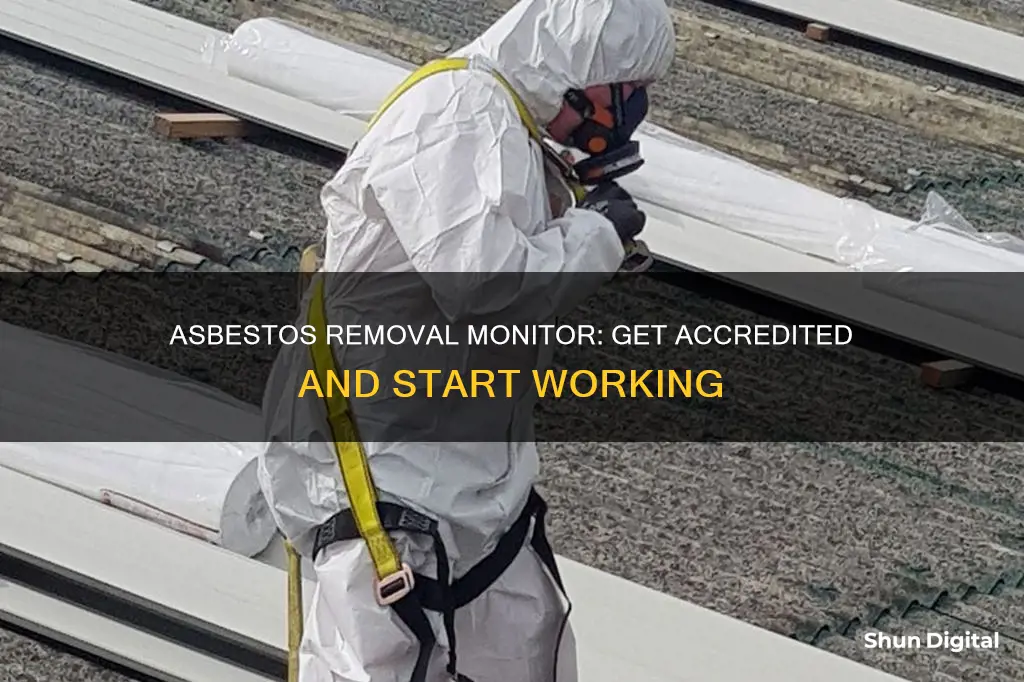
Asbestos is a highly hazardous material that poses serious health risks to those exposed to it. As a result, federal and local standards mandate that any contractor involved with asbestos abatement projects must be certified or face serious fines. To become an accredited asbestos removal monitor, you will need to meet specific prerequisites, complete a training course, pass an exam, and apply for certification. Accredited asbestos training courses are offered in several disciplines, including asbestos abatement worker, asbestos abatement supervisor, and project monitor. The training courses vary in length from two to five days, depending on the type of work you wish to perform. Most states also require a license to perform asbestos removal work.
| Characteristics | Values |
|---|---|
| Training Provider | EPA-approved or state-approved |
| Training Course Length | 2-5 days |
| Training Course Prerequisites | High school diploma, prior work experience, bachelor's degree, apprenticeship, engineering or architecture license |
| Training Course Topics | Roles and responsibilities, characteristics and uses of asbestos, potential exposure and health effects, sampling for analysis |
| Minimum Exam Score | 70% |
| Application Requirements | Candidate's photograph, copy of the training course certificate, employment information, education history |
| License Required | Yes |
| Annual Renewal | Yes |
What You'll Learn

Training requirements
- Worker
- Supervisor
- Project Manager
- Inspector
- Management Planner
Each discipline has prerequisites that need to be met before applying for a certificate. For example, project managers, inspectors, and management planners are required to have a high school diploma or degree in some cases. The supervisor, project manager, management planner, and project designer disciplines usually require some experience. However, individuals with certain professional licenses, like engineers and architects, may be exempt from these requirements.
To become a properly trained and accredited asbestos professional, you will need to seek training from a training provider approved by the EPA or a state to conduct asbestos training pursuant to the Asbestos Model Accreditation Plan. Most states also require a license to perform this work. A training course completion certificate is generally a prerequisite to applying for such a license. The training courses vary in length from two to five days, depending on the type of work you wish to perform. Accredited asbestos training courses are offered in the five separate disciplines listed above.
In addition to this initial training, asbestos professionals must take annual refresher training. The EPA has determined that online training can satisfy this requirement instead of in-person training, but the accrediting states must approve the online courses.
Finding Monitors with HDMI: A Quick Guide
You may want to see also

Examination
To become an accredited asbestos removal monitor, you will need to take an examination as part of your training course. The exact requirements of the examination will depend on the state in which you are seeking accreditation, and the discipline you are training in.
The training course will culminate in an exam, which you must pass to gain your certification. The pass mark is usually set at 70%. The exam will test your knowledge of the dangers of asbestos, and the correct procedures for handling and removing it. You will also be tested on the relevant federal and state laws and regulations surrounding asbestos.
The exam will cover the practical aspects of asbestos removal, including the correct use of safety equipment, such as respirators, and the proper methods for handling and disposing of asbestos. You will also be tested on the correct procedures for working in an asbestos-contaminated area, including setting up decontamination units and safety considerations.
In addition to the practical aspects, the examination will also cover the theory behind asbestos abatement. This will include the health effects of asbestos exposure, and the reasons for the various safety protocols. You will also be tested on the process of identifying asbestos, and assessing the damage to asbestos-containing materials.
The examination is designed to ensure that you have the knowledge and skills necessary to safely work with asbestos, and to comply with the relevant laws and regulations.
Internet Monitoring Software: Is Your Privacy at Risk?
You may want to see also

Application process
The application process for becoming an accredited asbestos removal monitor will vary depending on your location. In the United States, for example, the EPA Asbestos Model Accreditation Plan (MAP) requires the use of trained and accredited asbestos professionals when conducting asbestos inspections or designing or conducting response actions at schools and public and commercial buildings.
- Meet the prerequisites: Before qualifying for training and certification, you will need to meet certain prerequisites. In most cases, prior work experience in inspecting buildings or handling hazardous materials, or a related bachelor's degree, is required. Some states may also accept a completed apprenticeship or an engineering or architecture license.
- Seek training: Enrol in an accredited training course offered by approved training providers. These courses typically last between two to five days and cover topics such as the roles and responsibilities of an asbestos inspector, the characteristics and uses of asbestos, potential exposure, and health effects.
- Pass the exam: After completing your training, you will need to pass an exam to obtain your training course certificate. A score of 70% is generally considered a passing grade.
- Compile the required documents: Gather the necessary documents for your application, including a copy of your training course certificate, a photograph of yourself, employment information, and your education history.
- Apply for certification: Submit your application, along with the required documents, to the relevant certifying body. The specific certification body may vary depending on your location.
- Maintain your certification: Asbestos certifications typically expire every 12 months. To keep your certification valid, you will need to take annual refresher courses and apply for recertification. Failure to renew your certification may result in enforcement actions, including certificate suspension or revocation.
It is important to note that specific requirements and disciplines may vary by state or country, so be sure to check the requirements for your specific location. Additionally, some states or countries may have mutual agreements to honour certifications issued in other jurisdictions, but these agreements are not common.
Finding the Perfect Curve: Monitor Radius Explained
You may want to see also

Annual renewal
To maintain your accreditation as an asbestos removal monitor, you must renew your license annually. This involves completing an approved refresher training course and submitting your renewal application to the relevant state agency. The specific requirements for renewal may vary depending on your location, so it is important to check with your state agency for specific instructions.
For example, in Massachusetts, you must submit your renewal application at least 30 days before your current license expires to avoid delays in processing. In California, registrants must reapply each year and obtain a new certificate. Their compliance history over the past year and other information related to their ability to maintain a safe workplace are evaluated as part of the renewal process.
In New York, accredited asbestos professionals must complete annual refresher training and renew their certification with the Department of Labor Asbestos Licensing and Certification Unit. This training can be completed online or in person, but it must be approved by the state.
It is important to stay up to date with your accreditation and licensing requirements to avoid any interruptions in your ability to work as an asbestos removal monitor. Letting your license expire could result in having to repeat an initial course rather than a shorter refresher course.
Cleaning Your Monitor: Removing Spots and Maintaining Clarity
You may want to see also

State-specific requirements
New York
The New York State Department of Health outlines the requirements for becoming an accredited asbestos removal monitor in New York. The initial training program for project monitors should be a minimum of 40 hours, including six hours of hands-on training. The topics covered in the training include employee personal protective equipment, medical monitoring, roles and responsibilities of the project monitor, relevant federal, state, and local asbestos requirements, understanding building construction and systems, asbestos abatement contracts, specifications, and drawings, response actions and abatement practices, air monitoring strategies, safety and health issues other than asbestos, conducting visual inspections, legal responsibilities and liabilities of project monitors, record-keeping and report writing, and more.
Minnesota
In Minnesota, the state outlines specific requirements for performing asbestos air monitoring for an asbestos-related work project. These requirements include having a company licensed as an asbestos contractor by the Minnesota Department of Health (MDH), being certified as an asbestos worker or supervisor by the MDH, completing a Minnesota 2-Day Asbestos Air Sampling course or equivalent, and having a site supervisor present while any workers perform air monitoring.
Colorado
While not a comprehensive list of state-specific requirements, Zack Academy, an institution offering asbestos training, offers an asbestos air monitoring specialist course specific to Colorado.
Alabama, Florida, and Missouri
Zack Academy also offers online refresher courses for asbestos project designers specific to Alabama, Florida, and Missouri.
It is important to note that these are just a few examples of state-specific requirements for becoming an accredited asbestos removal monitor in the US. For comprehensive information on the requirements in a specific state, it is recommended to refer to the official websites of the respective state governments or contact the appropriate state agencies.
Why Subwoofers Enhance Rocket Monitors for a Superior Mix
You may want to see also







